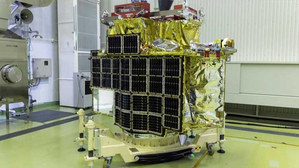Tokyo: The Japan Aerospace Exploration Agency’s (JAXA) Smart Lander for Investigating Moon (SLIM) has successfully entered lunar orbit on Christmas day, successfully setting the stage for the nation’s first-ever moon landing January 20, 2024, the agency said.
The robotic SLIM moon lander successfully inserted into lunar orbit at 16:51 (Japan Standard Time, JST) December 25, 2023, JAXA said in a mission update.
The 2.7 metres SLIM launched September 6 along with XRISM, a powerful X-ray space telescope.
If successful, Japan will become just the fifth country to successfully soft-land on the Moon, after Russia, US, China and India.
JAXA said that the lunar orbit of SLIM will be inserted into an elliptical lunar orbit connecting the Moon’s north and south poles with a period of approximately 6.4 hours, and altitude of about 600km at the closest point to the Moon (perilune), and 4,000km at the furthest point from the Moon (apolune). The orbit change proceeded as planned, and the spacecraft is currently in a normal condition.
“From now until mid-January 2024, the apolune point will be lowered, and the orbit adjusted to a circular orbit at an altitude of approximately 600km. The perilune point will then lower and preparations for landing will begin,” the update read.
“The perilune point will be lowered to an altitude of 15km January 19, and the descent towards the Moon will start at around 0:00am (JST) January 20. Landing on the lunar surface is scheduled for around 0:20am (JST) January 20.”
The agency had earlier noted that if the landing is not executed at the scheduled timing “a next opportunity is scheduled around February 16, 2024.”
If successful, SLIM will land on the slope of Shioli Crater, a relatively fresh, 300-metre-wide impact feature within Mare Nectaris, at 13 degrees south latitude and 25 degrees east longitude on the near side of the moon.
JAXA said that SLIM, also known as “Moon Sniper” in Japanese, “aims to achieve a pinpoint landing with an accuracy of less than 100 metres.”
“This marks an unprecedentedly high-precision landing on a gravitational body such as the Moon, and the results are anticipated to contribute to the programmes such as international space exploration that are currently under study,” the agency had said in a statement.
Japan has previously failed in two lunar landing attempts. JAXA lost contact with the OMOTENASHI lander and scrubbed an attempted landing in November, while the Hakuto-R Mission 1 lander, by Japanese startup ispace, crashed in April as it attempted to descend to the lunar surface.
IANS






































